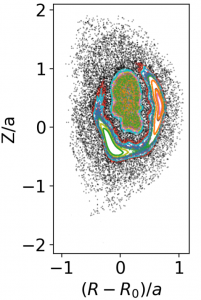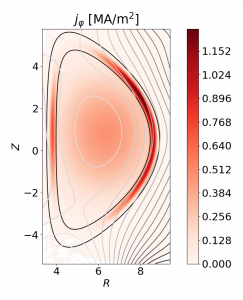Tokamak disruption mitigation

Disruptions pose one of the primary challenges to the tokamak reactor concept. During a tokamak disruption nearly all of the plasma’s stored thermal and magnetic energy are abruptly lost, leading to large thermal and electromagnetic loads on the surrounding vessel. If not properly mitigated, these loads can impart significant damage to the tokamak device, a concern which becomes more acute for reactor scale devices due to the larger content of thermal and magnetic energy. Our focus on this problem area has been to investigate the physics basis of a range of mitigation techniques including massive material injection and external waves.
Runaway electron formation and evolution
Highly relativistic populations of electrons have been observed to form under a range of conditions in tokamak plasmas. The formation of such a “runaway” electron population is of concern for tokamak plasmas due to the localized damage to the tokamak wall that can be imparted by a beam of runaway electrons. Our group has been focused on developing a computational capability in order to describe a range of runaway generation processes, as well as the mechanisms through which they can be avoided or suppressed.
Scientific machine learning

Our group is interested in applying scientific machine learning methods to a diverse range of problems in plasma physics and fusion energy. Here, our focus has been on embedding physical properties into the training of a deep neural network, yielding a deep learning framework capable of making accurate predictions utilizing a minimal amount of simulation or experimental data. Current applications include plasma kinetics, magnetohydrodynamic evolution, plasma-material interaction, and plasma thrusters.